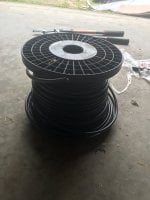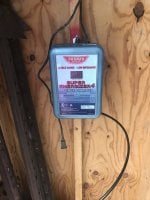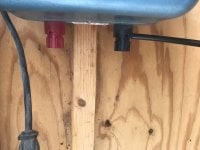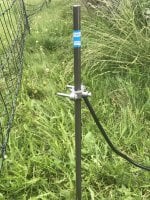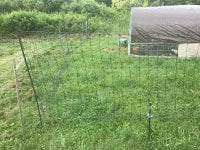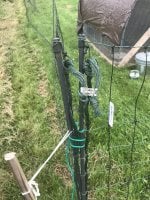goldeaglenest
Chirping
- Mar 13, 2017
- 48
- 8
- 54
I would be so grateful if some of you could comment on my electric fence setup. I am not entirely confident in what I am doing, but have read many things online and I still have some questions!
Here is what I have:
-Kencove electric netting, 48 inches tall and I believe about 140 ft. Long
-A spool of insulated wire
-Parmak Super Energizer AC fence charger low impedance 50 mile range, model SE4
I have shown my setup in pictures below, but here is the description:
I cut one length of the insulated wire and stripped each end. Then I attached one end to the black (grounding) knob on the charger and the other to the grounding pole which is a 3 foot steel rod pounded with about a foot above ground. Soil is moist, groundwaterbisnpretty closensoni didn't want to pound the whole thing in (not sure if this matters?). The grounding rod is about three feet away from the the charger which is right inside the garage. It is about six inches away from the outside of the fence.
I'm stuck on the next step:
Attaching the charger to the fence itself via insulated wire running from the positive (red) knob on the charger to the bundle of wires where the two ends of the fence meet.
How do I attach the (soon to be) live wire to the bundle of wires on the fence? Do I need to buy another part to do this?
Do I cut another length of wire from the charger in the garage to where the bundle of wires is on the fence? This length will change every time I move the fence...can I just leave the wire on the spool and have one end on the charger and the other end on the fence so that I don't have to cut the wire and risk not having enough length for the next time I move the fence?
In the pictures, you will see a zoomed out view that shows the grounding rod in the foreground. The place where the two ends of the fence meet and are clipped together is almost directly across from the grounding rod. This distance is about 20 ft.
And lastly,
How do I get into the fenced area to feed the chickens etc every day. Seems like this would be such a hassle! I've been using the fence without electrifying it, so it's been easy to get in and out, but I need to electrify it for purposes of keeping dogs and wild animals out and some of the more curious chickens in.
I appreciate the help and anything that looks wrong, let me know!!! Thanks!!
Here is what I have:
-Kencove electric netting, 48 inches tall and I believe about 140 ft. Long
-A spool of insulated wire
-Parmak Super Energizer AC fence charger low impedance 50 mile range, model SE4
I have shown my setup in pictures below, but here is the description:
I cut one length of the insulated wire and stripped each end. Then I attached one end to the black (grounding) knob on the charger and the other to the grounding pole which is a 3 foot steel rod pounded with about a foot above ground. Soil is moist, groundwaterbisnpretty closensoni didn't want to pound the whole thing in (not sure if this matters?). The grounding rod is about three feet away from the the charger which is right inside the garage. It is about six inches away from the outside of the fence.
I'm stuck on the next step:
Attaching the charger to the fence itself via insulated wire running from the positive (red) knob on the charger to the bundle of wires where the two ends of the fence meet.
How do I attach the (soon to be) live wire to the bundle of wires on the fence? Do I need to buy another part to do this?
Do I cut another length of wire from the charger in the garage to where the bundle of wires is on the fence? This length will change every time I move the fence...can I just leave the wire on the spool and have one end on the charger and the other end on the fence so that I don't have to cut the wire and risk not having enough length for the next time I move the fence?
In the pictures, you will see a zoomed out view that shows the grounding rod in the foreground. The place where the two ends of the fence meet and are clipped together is almost directly across from the grounding rod. This distance is about 20 ft.
And lastly,
How do I get into the fenced area to feed the chickens etc every day. Seems like this would be such a hassle! I've been using the fence without electrifying it, so it's been easy to get in and out, but I need to electrify it for purposes of keeping dogs and wild animals out and some of the more curious chickens in.
I appreciate the help and anything that looks wrong, let me know!!! Thanks!!

